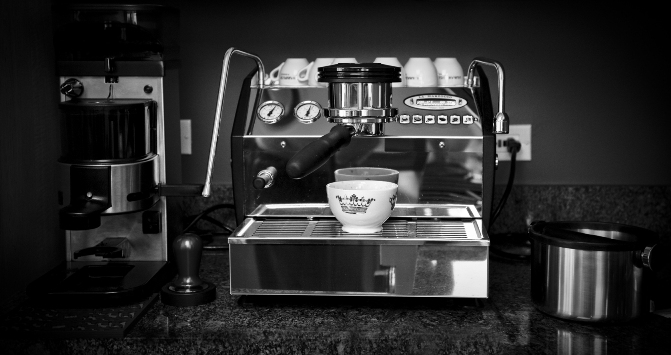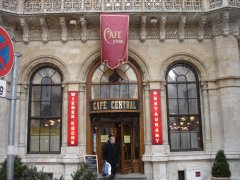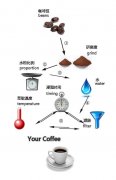Commercial semi-automatic coffee machine derived from the "perfect steam theory" of coffee extraction
Gestation period: before 1900
Perfect Steam Theory of Coffee extraction
In 1818, Dr. Romershausen obtained a patent for "extractor" in Prussia.
In 1822, the Frenchman Louis Bernard Rabout obtained a patent to obtain a cleaner extract based on the characteristics of oil-absorbing ink paper combined with the design of Dr. Romershausen.
In 1824, Caseneuve, a Parisian craftsman, designed a coffee utensil that was too complex to make, hoping to avoid the loss of aroma.
In 1827, Laurens's patent in France emphasized the need to wet coffee powder with steam before coffee extraction.
In 1833, Samuel Parker, an Englishman, invented using a pump to pump water up through coffee instead of letting it flow down. (he paid special attention to the fact that the good taste of coffee first appeared bitter and was extracted in the later stage.)
In 1838, Leburn, an optician in Paris, designed a number of small table coffee makers, which were very popular in southern Europe.
In 1840, Tiesset designed a vacuum pump to pull hot water down with extra force through coffee powder.
In 1844, Frenchman Cordier painted a number of coffee extractors in his patent, one of which was very similar to Eicke's German machine 30 years later.
In 1847, Romershausen made a steam pressure coffee pot.
In 1855, the Frenchman Loysel introduced a large-capacity bar coffee machine (about 4.5m high), which claims to make 10000 cups of coffee a day.
In 1868, the Viennese Reiss developed a new type of "Viennese pot".
In 1885, the Italian Angelo Moriondo signed a patent for coffee that could make 50 cups at a time.
Childhood: 1901-1947
Exclusive privilege of one cup of coffee at a time
The coffee machine designed by Luigu Bezzera in 1901 was successfully patented.
In 1902, his friend Desiderio Pavoni added a pressure relief piston device to the machine and commercialized the machine for production and sale.
In 1903, Bezzern sold the patent to Pavoni at a cost of 10, 000 lire due to financial difficulties.
In 1905, La Pavoni Company was announced.
In 1906, the Italian Arduino applied for a patent to install a heat exchanger in the machine to heat the water quickly.
In 1909, Luigi Giarlotto added a pump to the machine to solve the problem of insufficient pressure in the extraction.
In 1910, his second patent was the screw-down piston, which squeezed out all the delicacies of coffee from the piston.
In 1935, Dr. Illy invented the first machine to use compressed air to push water through coffee powder.
Since 1938, the placement of the boiler has been successfully improved from the original vertical to horizontal.
Puberty: 1948-1961
The pressure increases and the water temperature decreases; the birth of the "gold bubble"
In 1948, Gaggia introduced the piston lever spring coffee machine to the market.
In 1952, the large vertical machine disappeared overnight.
In 1956, Cimbali used hydraulic systems to avoid consuming too much effort when using levers.
Maturity: after 1962
The popularization of electronic parts; the advantages of "heat exchange and heat cycle"
In 1955, Giampietro Saccani took an important step to keep the temperature of the cooking head stable.
In 1961, Italy and Spain jointly produced the E61 model. In the past, hot water was pressurized, but now it is pressurized and then heated, which is a perfect revolution compared to the past.

Important Notice :
前街咖啡 FrontStreet Coffee has moved to new addredd:
FrontStreet Coffee Address: 315,Donghua East Road,GuangZhou
Tel:020 38364473
- Prev

The Central Cafe in Vienna originated in Vienna.
Vienna is a city with no lack of culture, located in the center of Europe, known as the capital of the whole Europe, once all-powerful politicians and all kinds of literati, musicians and artists have gathered here. Vienna, as a cultural city, is no less than the established European cities-Paris, Venice, Rome. In many legends, cafes originated in Vienna
- Next

Hand-brewing coffee making skills what factors affect a cup of hand-brewed coffee
Among the many brewing methods, hand brewing can be said to be the most popular coffee brewing method, which is simple, easy to learn, easy to control, and the taste can be accepted by most people. But there are also many friends who are not sure how to find the taste that suits them when making, what factors affect a cup of hand coffee and how influential it is. Hand-made coffee consumables: coffee
Related
- Beginners will see the "Coffee pull flower" guide!
- What is the difference between ice blog purified milk and ordinary milk coffee?
- Why is the Philippines the largest producer of crops in Liberia?
- For coffee extraction, should the fine powder be retained?
- How does extracted espresso fill pressed powder? How much strength does it take to press the powder?
- How to make jasmine cold extract coffee? Is the jasmine + latte good?
- Will this little toy really make the coffee taste better? How does Lily Drip affect coffee extraction?
- Will the action of slapping the filter cup also affect coffee extraction?
- What's the difference between powder-to-water ratio and powder-to-liquid ratio?
- What is the Ethiopian local species? What does it have to do with Heirloom native species?

